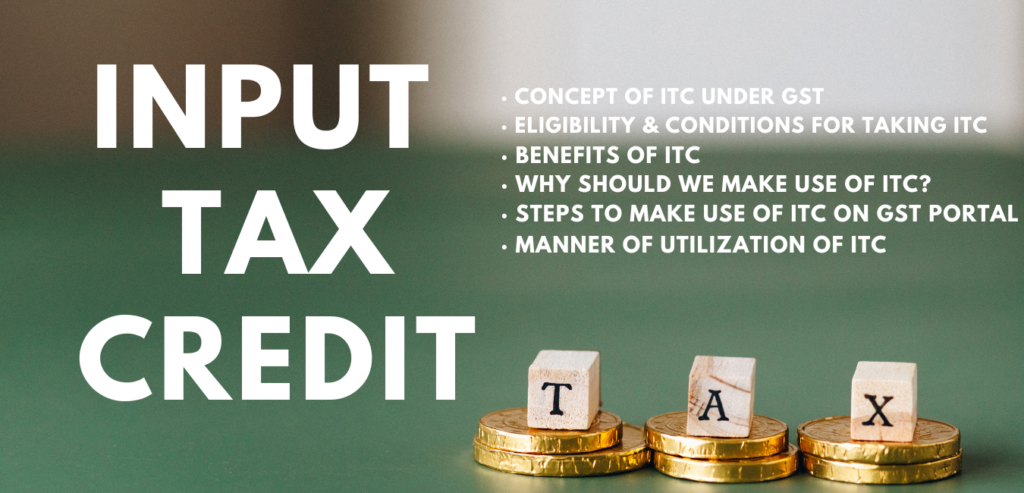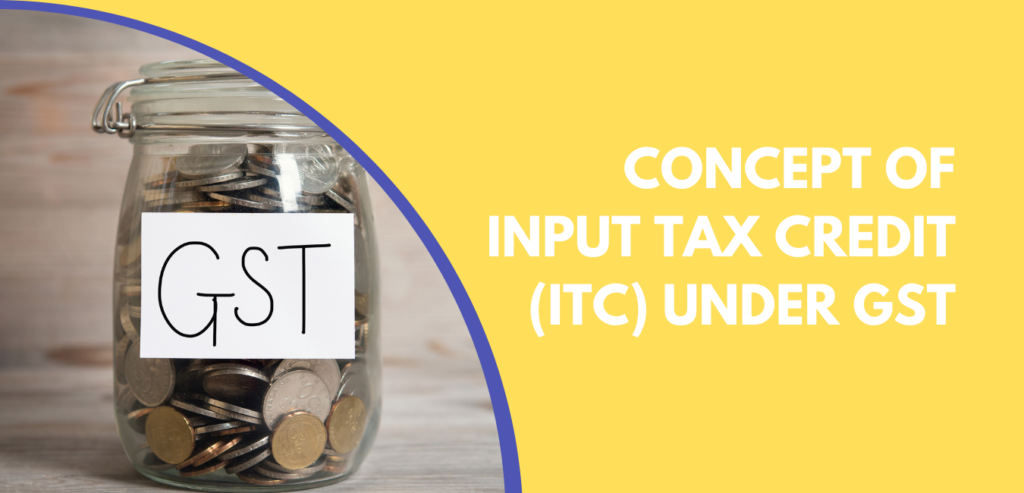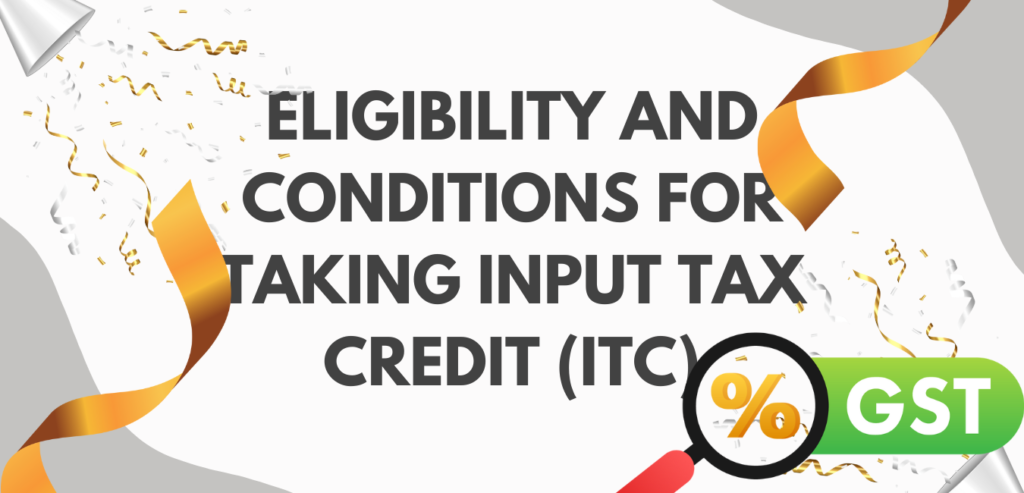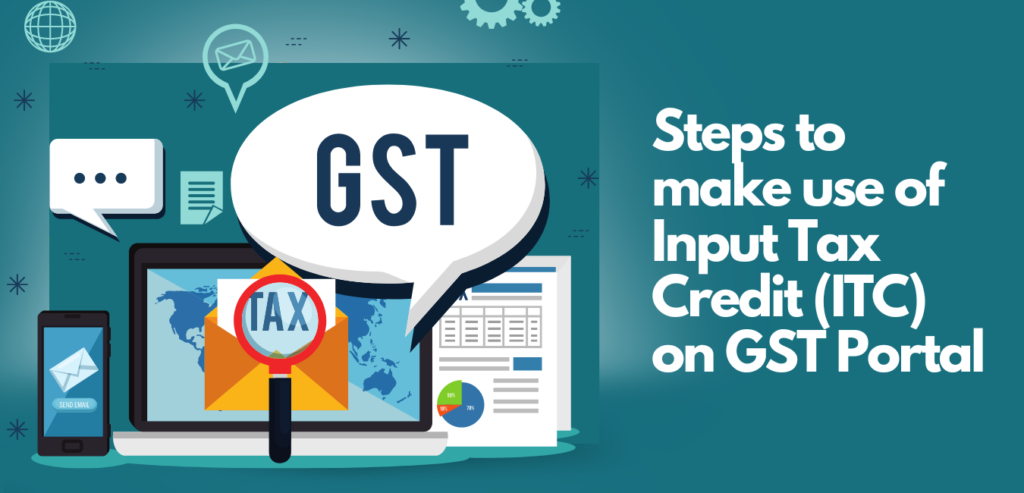
Introduction
GST is a path breaking indirect tax reform which was introduced with a vision to bring significant benefits to all the stakeholders. The simplified tax structure has been designed in such a manner that it eradicates cascading of taxes across the entire supply chain, thereby making goods and services more competitive. One of the key features of GST is introduction of comprehensive input tax credit mechanism which proved to be a win-win situation for the entire nation. Let’s discuss this in detail.
Concept of Input Tax Credit (ITC) under GST

ITC stands for “Input Tax Credit”. Under ITC Mechanism, tax is collected at every stage of the supply chain and credit of tax paid at the previous stage is available as set off at the next stage of transaction.
The flow of credit under GST can be better understood with the help of an illustration:
Mr. X, a trader purchased goods worth Rs.10000/- and paid GST @18% on 10000 i.e. 1800/- is the tax paid on purchases (known as Input Tax)
Further he sold goods to the end consumer for Rs.20000/- and collected GST@18% on 20000 i.e. 3600/- is the tax collected from the customer (known as Output Tax) which should be paid to the government.
Now under the new indirect tax regime, trader is not required to pay entire tax collected from the customer i.e. 3600 to the government. This is so because he will get credit of input tax which he already paid at the time of purchase i.e. 1800 is the ITC of the trader which will be allowed as deduction from the output tax payable. Hence net tax payable will be Output tax less Input Tax i.e. 3600-1800=1800/- only.
Eligibility and Conditions for taking Input Tax Credit (ITC)

It should be noted that ITC is available only to the registered person and that too only when the following conditions prescribed under relevant sections of the GST Act is complied with:
- Goods/Services have been received
- Valid tax invoice/debit note/prescribed tax paying document has been issued
- Returns prescribed under the Act have been furnished
- Tax on such supply has been deposited/paid to the government either in cash or by claiming input tax credit
Benefits of Input Tax Credit (ITC)
Such a seamless availability of input tax credit and a transparent and complete chain of set offs across the entire supply chain gave huge relief especially to small business owners and entrepreneurs and resulted in better tax compliance as well.
It has mitigated the ill effects of cascading of taxes as only the value added at each stage is being taxed under GST. This helped in streamlining of business operations across the nation and has reduced the tax burden to a great extent.
The robust mechanism has reduced the instances of tax evasion and controlled various malpractices which were practiced in the earlier tax regime by taking advantage of loopholes in the law. This became possible because in order to avail and claim ITC, one needs to issue proper invoices, maintain record of all the transactions, submit returns and taxes on timely basis, etc.
Why should we make use of Input Tax Credit (ITC) to save GST?
Since ages it’s a known fact that taxpayers do tax planning so that they can minimize their tax liability by making use of opportunities provided by law makers within the foreclosures of law.
Under GST, the input tax credit mechanism provides us the opportunity to utilize ITC available in the electronic credit ledger while making payment towards output tax liability.
The electronic credit ledger records all input taxes paid by the taxpayer based on the return submitted by the taxpayers. The taxpayers can then use the credit to the extent available in the e-credit ledger to offset GST liability and remaining liability will have to be paid in cash.
For example: Mr. X has an output tax liability of Rs.5000 and ITC available in the E-Credit Ledger is Rs.1500. In the given case, taxpayer can discharge tax liability of Rs.1500 through E-credit Ledger and balance Rs.3500 will have to be paid through cash/bank payment which will be reflected in E-Cash Ledger.
ITC on invoices pertaining to a current financial year should be availed any time till the due date of filing return for month of September of next financial year or date of filing of annual return, whichever is earlier.
If the benefit of ITC is not availed within the time limit prescribed, then ITC will automatically lapse in favor of the government.
In some cases it might be possible that tax rate on input (purchase) is always higher than tax rate on output (sale), then you get an option to either carry forward ITC or claim refund of ITC.
Hence ITC plays an important role in lowering the tax burden on an average dealer in trade and industry as the person may use ITC to pay his output tax liability.
Steps to make use of Input Tax Credit (ITC) on GST Portal

The Common GST Portal set up by the government for all GST related services is www.gst.gov.in
Let’s try to understand how ITC Mechanism works on GST Portal:
- Supplier of goods/services have to upload invoice wise details of sales made during every month/quarter in his form GSTR 1
- Purchaser of goods/services are given the facility to view the invoices uploaded by the supplier in his form GSTR 2
- Now while filing FORM GSTR 3B, purchaser can claim ITC based on the tax invoices reflected in his GSTR 2.
The claims can be maximum upto 105% of the eligible ITC for a particular tax period. For example: Total ITC as per invoice amounts to 6 lakhs but supplier furnished invoices on GST Portal involving ITC of 4.8 lakhs only, then eligible ITC = 4.8 lakhs + 5% of 4.8 lakhs i.e.20000 = 5 lakhs.
GST being a highly automated process matches the input tax credit that you claimed with the corresponding tax invoice being uploaded on the website and if there are no mismatches found then only you become eligible to claim the benefit.
You have to be very careful while claiming ITC because in case any discrepancy is found when the system reconciles, then notice might be issued to you seeking explanation for the same. If the reply is not satisfactory, department can deny the benefit of ITC and excess ITC already claimed by the recipient shall be reversed and then added to output tax liability along with interest and penalty.
Manner of utilization of Input Tax Credit (ITC)
ITC available in E-Credit Ledger is utilized as follows on GST Portal:
- ITC of IGST is first utilized towards payment of IGST & any remaining amount shall be utilized towards payment of CGST & SGST in any ratio.
- ITC of CGST shall be first utilized for payment of CGST & any remaining amount shall be utilized only towards payment of IGST.
- ITC of SGST/UTGST shall be first utilized for payment of SGST/UTGST & any remaining amount shall be utilized only towards payment of IGST.
The above discussed mechanism ensures that there is a minimum tax payout on the part of taxpayer after he/she offsets ITC available against output tax liability.
No doubt, the mechanism of input tax credit is the backbone and lifeline of GST regime.

